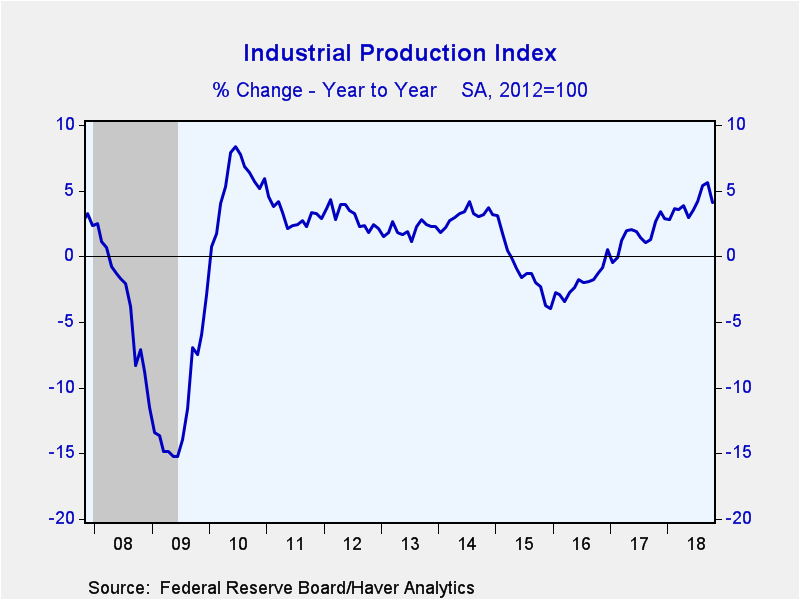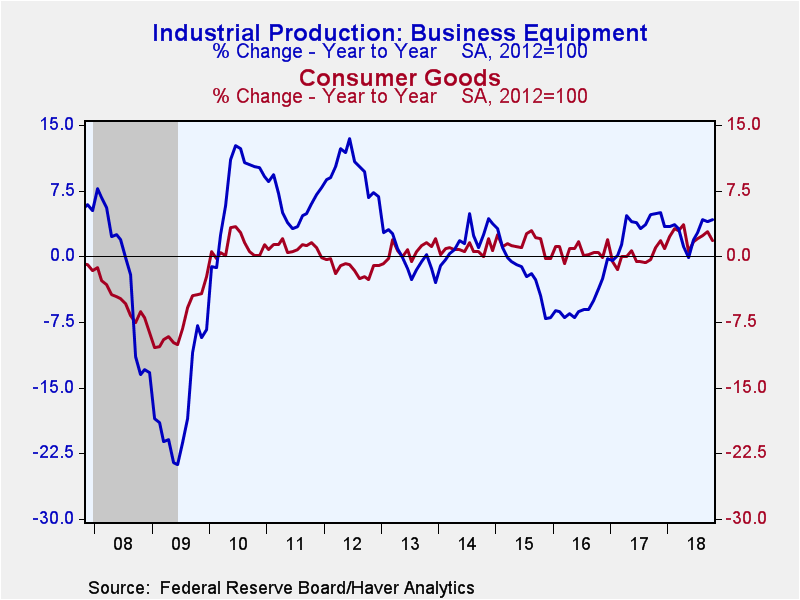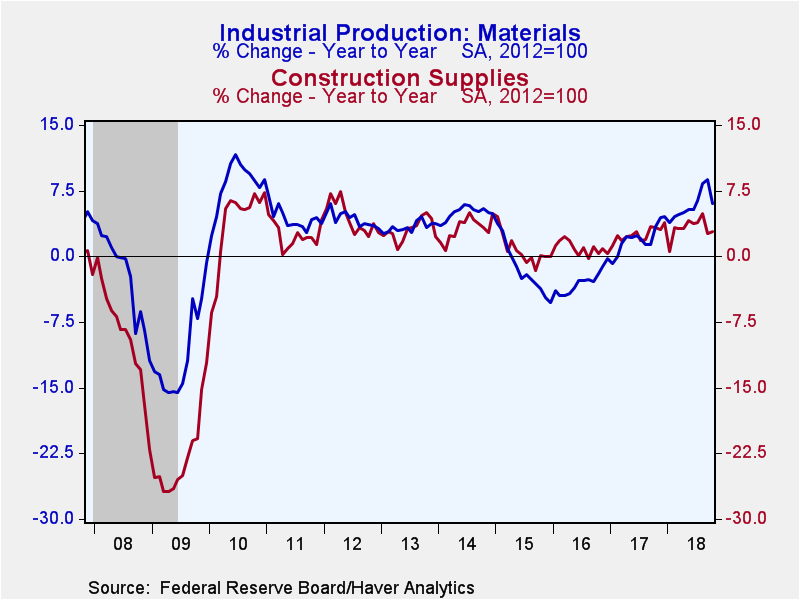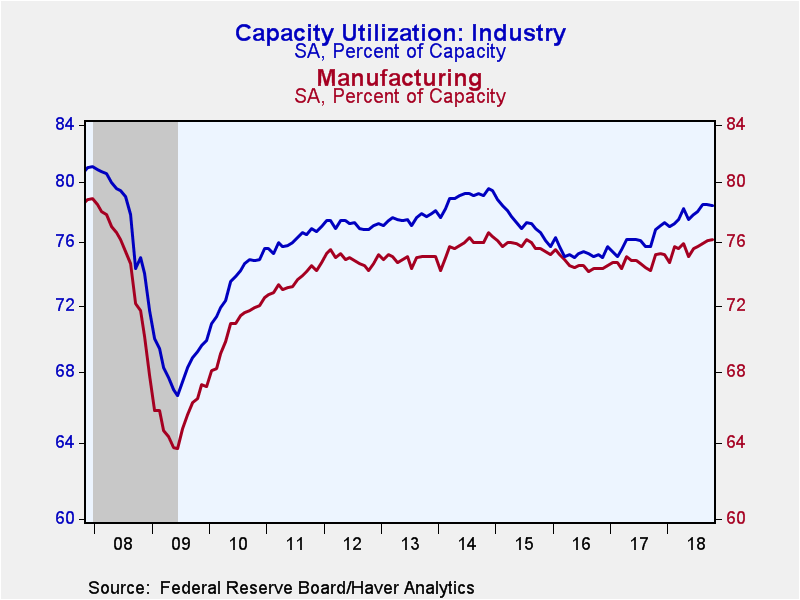 Global| Nov 16 2018
Global| Nov 16 2018U.S. Industrial Production Gains Weaken
by:Tom Moeller
|in:Economy in Brief
Summary
Industrial production rose 0.1% (4.1% y/y) during October following a 0.2% September improvement, revised from 0.3%. The 0.8% gain in August output was revised from 0.4%. October's rise was the smallest since a decline in May. A 0.2% [...]
Industrial production rose 0.1% (4.1% y/y) during October following a 0.2% September improvement, revised from 0.3%. The 0.8% gain in August output was revised from 0.4%. October's rise was the smallest since a decline in May. A 0.2% improvement had been expected in the Action Economics Survey. Manufacturing activity increased 0.3% (2.7% y/y) during October, the same as in September which was revised from 0.2%. Utilities output fell 0.5% (+1.7% y/y) after a 0.1% easing while mining production fell 0.3% (+13.2% y/y) following a 0.1% slip.
The rise in manufacturing output was held back by a 2.8% decline (+2.1% y/y) in motor vehicles and parts output which followed two months of firm growth. Furniture & related product production gained 0.7% (1.8% y/y) and recouped the prior month's decline. Computer, video and audio product production held steady (-0.7% y/y) after declining for two months.
Production of nondurable goods improved 0.2% (1.8% y/y) as paper output rebounded 0.9% (1.4% y/y) following two months of decline. Chemical production improved 0.3% (2.7% y/y) after falling 0.4%. Offsetting these gains, petroleum & coal product output worked 1.1% lower after two months of moderate increase, and was unchanged y/y. Apparel production fell 1.9% (-4.4% y/y), the fifth sharp decline in the last six months.
Business equipment production strengthened 0.8% (4.1% y/y) for the second consecutive month. Industrial & other equipment production jumped 1.7% (4.5% y/y) following a 0.5% rise. Information processing equipment production improved 0.6% (4.5% y/y) following no change during September. Transit equipment output fell 0.9% (3.0% y/y) after two months of strong increase.
Finally, construction supplies output rebounded 0.6% (2.9% y/y) and recovered the prior month's decline. Production of materials eased 0.1% (+6.1% y/y) as energy materials output fell 0.5% (+10.2% y/y).
In the special aggregate groupings, production of high technology products held steady (5.9% y/y) for the second consecutive month. Semiconductor & electronic component production fell 0.8% (-0.7 y/y). Computer & peripheral production rebounded 2.8% (6.8% y/y) following three months of sharp decline. Factory sector production excluding the motor vehicle and high tech sectors improved 0.5% (2.7% y/y). That followed 0.2% increases in three of the prior four months.
Capacity utilization eased to 78.4% but remained up from a 75.0% low touched in November 2016. Factory sector utilization inched up to 76.2%, but mining sector utilization eased to 92.7%. Capacity in the manufacturing sector increased 1.2% y/y after last year's 1.0% rise.
Industrial production and capacity data are included in Haver's USECON database, with additional detail in the IP database. The expectations figure is in the AS1REPNA database.
| Industrial Production (SA, % Change) | Oct | Sep | Aug | Oct Y/Y | 2017 | 2016 | 2015 |
|---|---|---|---|---|---|---|---|
| Total Output | 0.1 | 0.2 | 0.8 | 4.1 | 1.6 | -2.0 | -1.0 |
| Manufacturing | 0.3 | 0.3 | 0.4 | 2.7 | 1.2 | -0.8 | -0.6 |
| Consumer Goods | 0.2 | 0.4 | 0.4 | 1.8 | 0.0 | 0.7 | 1.5 |
| Business Equipment | 0.8 | 0.8 | 1.6 | 4.1 | 3.2 | -5.3 | -2.0 |
| Construction Supplies | 0.6 | -0.6 | 0.4 | 2.9 | 2.5 | 0.9 | 0.6 |
| Materials | -0.1 | -0.1 | 1.2 | 6.1 | 2.0 | -3.0 | -1.5 |
| Utilities | -0.5 | -0.1 | 1.1 | 1.7 | -1.3 | -0.4 | -0.8 |
| Mining | -0.3 | -0.1 | 2.4 | 13.2 | 6.4 | -9.7 | -3.4 |
| Capacity Utilization (%) | 78.4 | 78.5 | 78.5 | 76.8 | 76.1 | 75.4 | 77.3 |
| Manufacturing | 76.2 | 76.1 | 75.9 | 75.2 | 74.8 | 74.6 | 75.8 |
Tom Moeller
AuthorMore in Author Profile »Prior to joining Haver Analytics in 2000, Mr. Moeller worked as the Economist at Chancellor Capital Management from 1985 to 1999. There, he developed comprehensive economic forecasts and interpreted economic data for equity and fixed income portfolio managers. Also at Chancellor, Mr. Moeller worked as an equity analyst and was responsible for researching and rating companies in the economically sensitive automobile and housing industries for investment in Chancellor’s equity portfolio. Prior to joining Chancellor, Mr. Moeller was an Economist at Citibank from 1979 to 1984. He also analyzed pricing behavior in the metals industry for the Council on Wage and Price Stability in Washington, D.C. In 1999, Mr. Moeller received the award for most accurate forecast from the Forecasters' Club of New York. From 1990 to 1992 he was President of the New York Association for Business Economists. Mr. Moeller earned an M.B.A. in Finance from Fordham University, where he graduated in 1987. He holds a Bachelor of Arts in Economics from George Washington University.










